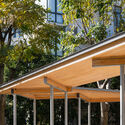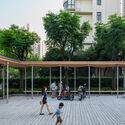
-
Architects: Atelier Z+
- Year: 2021
-
Photographs:Min Yang

Text description provided by the architects. The Service Station in Front of Putuo Park is one of the three citizen service stations which were first constructed for demonstration in the Project on Public Space Connection of Both Banks of Suzhou Creek, Putuo Section. It is located on the southeast side of the main gate of Putuo Park. The Putuo Section of Suzhou Creek has many bends, and both bank areas are one of the origins of China’s modern national industries. The Yaoshuilong (Chemical Lane) Peninsula across the river from Putuo Park was once one of the famous shanty towns where industrial workers lived in early Shanghai. Putuo Park, which was completed and opened in early 1954, is the first urban park built in Putuo District after the founding of the People's Republic of China. It is adjacent to the elevated light rail line transformed from the Shanghai-Hangzhou Railway to the north, and its southeast main gate opens to West Guangfu Road and is close to the north end of Yaoshuilong Bend of Suzhou Creek.



The main gate retreats from the road, and forms a small park front open area with the walls of the residential quarters on both sides. The western half of the site is a small pass-through park entrance square with hard pavement, which is often occupied by various types of vehicles; the eastern half is an event space with a raised floor, surrounded by flower beds, grass, and trees. It is mostly shaded with few people staying there. The service station in front of Putuo Park is aimed to explore how to revitalize urban space resources in the context of urban renewal. With the site of the service station as a link, the riverside greenbelt of Suzhou Creek and Putuo Park are connected to improve the environmental quality and space vitality, as well as shape the daily public space friendly towards the community.

As each site of Suzhou Creek Service Station is cramped and complex, it is impossible to set up a service station with a standardized form. We adopt a manual charging and componentized spatial configuration method. We regard the different functional spaces that constitute the service station, such as toilets, lounges, showrooms, small gardens, eaves galleries, etc. as relatively standard spatial components and modules of different specifications, and the way of assembly of components is adjusted and customized according to site conditions. Focusing on reintegrating the park entrance space, a pleasing cloister in front of the park's sliding door is arranged as a new park porch vestibule.

People can either walk through or take a rest under the west porch next to the flower bed. This cloister has also become a core space of the entire station. The service station extends to the irregular site on the east side of the corridor, where the lounge and the showroom are arranged in sequence. The lounge and the west and south sides of the showroom are surrounded by eaves galleries, and between them, there is a long and narrow courtyard garden, shaded by trees and rocks, called "Puyuan Garden". A citizen-friendly niche-style 24-hour service facility is arranged under the eaves of the showroom in the southeast corner, and non-motor vehicle parking spaces are set up along the road outside.
The service station also presents a continuous open horizontal eaves gallery to the road, and the rooms rise from behind the eaves gallery. The original park lodge on the north side between the entrance cloister and the lounge has also been renovated and connected with the service station. Since there is a public toilet nearby in the park, the public toilet in the service station has been reduced to the smallest cubicle and arranged in the irregular gap between the park lodge and the fence. The north side of the showroom is combined with reserved trees to form a small quiet backyard garden, and the surrounding wall is lined with a green plant wall as the background. People can either sit in the backyard looking across the eaves gallery to Puyuan Garden or overlook the park entrance vestibule through the lounge on the west side of Puyuan Garden.


As the flood control wall along the river is high, the view from the ground floor is obstructed, a roof garden is set on the lounge and showroom, which is reached by an outdoor steel ladder on the east side of the backyard close to the fence, and two roofs are connected by a small sky bridge over Puyuan Garden. On the roof lawn, there are irregularly staggered long square wooden steps. The roof of the northern half of the lounge is raised step by step to become a timber-paved roof star theater facing the river. Under the shade of the nearby tree canopy, people will find panoramic river bends all in sight on the riverbank. We designed the building in a proper place in order to keep all eight large trees with a diameter of more than 30cm at breast height on the west and south sides of the site and the backyard in the northeast. Also, we maintained continuous flower beds on the west and south sides and optimized the planting. As a result, the original site character of being basically covered by the shade of trees continues.

In order to reduce the construction difficulty in such a narrow site and ensure that the daily access to the park is not affected during the construction period, the whole building adopts a glued laminated timber construction system of hybrid wood-steel structure with a high assembly rate. The slender round steel columns of the cloister and eaves galleries are misaligned inside and outside, thus forming the characteristic rhythmic continuous cross-skew beams of the corridor roof. The vertical structure of the lounge and showroom adopts an asymmetrical arrangement to induce internal force transfer. On one side is all relatively thick square columns that are hidden on a bookshelf or wall. They can resist most of the horizontal force.

The other side is relatively slender round columns which maintain a similar structural scale to eaves columns. They are mainly subjected to vertical loads. The interior ceiling features exposed one-way ribbed beams combined with lighting. The north side of the lounge introduces a soft north-facing high-side skylight as the roof rises. The solid exterior walls of the lounge and showroom are covered with anodized aluminum slabs, and the exterior walls of the park lodge and toilets are covered with deep carbonized anti-corrosion SYP timber panels. The roofs on cloisters and eaves galleries are made of aluminum-magnesium-manganese alloy sheeting with upright seams.






















































